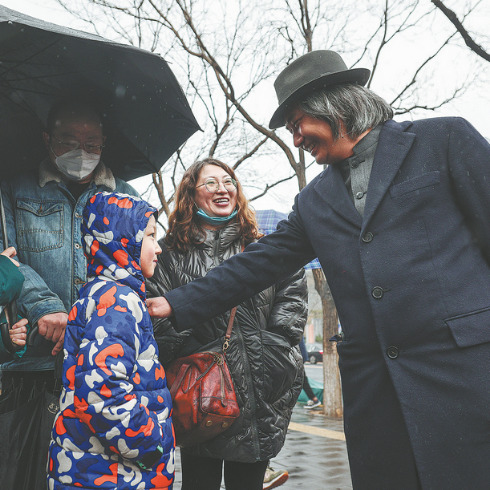



Artist, CPPCC member and museum director, Wu Weishan reiterates the importance of nurturing wider public interest in pursuits of an aesthetic nature, Lin Qi reports.
Long queues of visitors formed outside the National Art Museum of China on a Sunday afternoon, despite Beijing being engulfed in the chills of early February, and people having to hold umbrellas to shelter from falling sleet. They all came for the same exhibition, Beauty in Greatness Through Details, which occupies all of the museum's halls and comprises 1,000 paintings, prints, watercolors and sculptures of smaller sizes. Some are from the collection of National Art Museum of China and are representative works of preeminent figures of the 20th-century Chinese art.
Wu Weishan, the museum's director and a noted sculptor, joined the people waiting in line and engaged in conversation with them, asking such questions as: "Are you from Beijing?" "Do you visit the National Art Museum of China often?" "Do you have any suggestions to improve our services at the museum?"
Mounting a curated exhibition to celebrate the Chinese New Year, which normally runs from January through March, has been a routine at the museum in recent years under Wu's stewardship. The show consistently draws an influx of visitors from across the country, especially on weekends and public holidays. Wu says it is good to see that people are willing to devote their precious time to viewing the selected works of the State's collection, which is diverse and immense.
"What I have felt is people's rising need for aesthetic and arts education, and that comes as both a pressure and encouragement for us working at museums, to make the best of the nation's collection of art and to stage as many quality shows as possible," he says.
To utilize the rich resources of a public museum, or artists, for the greater good of people and the country has been a focus of Wu's duties as a museum administrator, a sculptor and also a member of the Standing Committee of the National Committee of the Chinese People's Political Consultative Conference, the nation's top political advisory body.
"I have seen a recent trend toward cultivating people and developing culture with the aid of arts education in a comprehensive manner. Many cities, such as Shanghai, Chongqing, Chengdu (Sichuan province) and Shenzhen (Guangdong province) put a lot of value on the integration of art in the course of boosting their respective images," he says.

At the annual CPPCC session, which opened on Saturday in Beijing, Wu proposed key initiatives to stimulate arts education for the public, one of which was that it should be rooted in the country's excellent culture. "On one hand, it requires the carrying on of the best of traditional cultures which accumulated the wisdom of Chinese civilization formed over centuries, and on the other hand, our practices should also integrate the new cultures which have been created and reflect the need of Chinese people over the past century and under the banner of Communist Party of China."
He says it should be a social norm that arts education is all-encompassing and a type of lifelong learning. "Our job is to allow people to feel the beauty of physique, morality, thought, vision and nature, all the aspects of a person's life; and the education is accessible to everyone, anytime and anywhere."
He says that arts education should be a practice without boundaries, and should break them in both a geographic and disciplinary sense. Venues should not only include museums and art galleries, music halls, theaters and culture centers, he says, but art should also be brought to the "doorsteps of people's homes" — communities at the grassroots level and other public spaces closer to people's day-to-day lives.

On Friday, a statue created by Wu of Lei Feng, the hero soldier, was unveiled at the bustling Wangfujing shopping street, along the Chang'an Avenue. The young man was made a national icon in the 1960s because of his virtuous attitude and spirit of self-sacrifice. Following his death at just 22 years old, Chairman Mao Zedong called on the nation to learn from his sense of duty and since then, March 5 has been marked as "Learn From Lei Feng Day".
The sculpture by Wu depicts the soldier walking and smiling in the pleasant spring breeze. Its installation in Wangfujing also symbolizes the beginning of a long-term collaboration between the National Art Museum of China and Dongcheng district, which administers Wangfujing, to place more statues of heroic figures in public places.
Wu initiated a program five years ago to create statues of role models, like Lei Feng, who have made a contribution to the People's Republic of China. He and dozens of young sculptors have produced more than 50 such works. Luminaries in different areas, such as teachers, scientists and factory workers, have been invited to the National Art Museum of China to sit for portraiture, and the process is sometimes open to the public. Exhibitions of these statues have toured nationwide, to schools and communities.
"One or two hundred years later, people will learn about our time, not only from books, but also from these sculptures," Wu says. "They will feel the character of these representative figures, the hard work they have done and the sacrifices they have made for this country and its people."
He said at the recent meeting of the CPPCC that the program should be accessible to more people via exhibitions and online, and the works should be toured to, or installed in, more public spaces, so that the deeds and spirit of those depicted will be passed on.
Contact the writer at linqi@chinadaily.com.cn


If you have any problems with this article, please contact us at app@chinadaily.com.cn and we'll immediately get back to you.